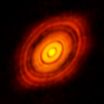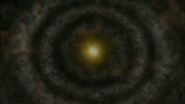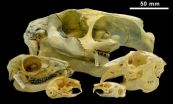"These features are almost certainly the result of young planet-like bodies that are being formed in the disc. This is surprising since such young stars are not expected to have large planetary bodies capable of producing the structures we see in this image," said Stuartt Corder, ALMA Deputy Director.
"When we first saw this image we were astounded at the spectacular level of detail. HL Tauri is no more than a million years old, yet already its disc appears to be full of forming planets. This one image alone will revolutionise theories of planet formation," explained Catherine Vlahakis, ALMA Deputy Program Scientist and Lead Program Scientist for the ALMA Long Baseline Campaign.
HL Tauri's disc appears much more developed than would be expected from the age of the system. Thus, the ALMA image also suggests that the planet-formation process may be faster than previously thought.
Such high resolution can only be achieved with the long baseline capabilities of ALMA and provides astronomers with new information that is impossible to collect with any other facility, even the NASA/ESA Hubble Space Telescope. "The logistics and infrastructure required to place antennas at such distant locations required an unprecedented coordinated effort by an expert international team of engineers and scientists," said ALMA Director, Pierre Cox. "These long baselines fulfill one of ALMA's major objectives and mark an impressive technological, scientific and engineering milestone."
Young stars like HL Tauri are born in clouds of gas and fine dust, in regions which have collapsed under the effects of gravitation, forming dense hot cores that eventually ignite to become young stars. These young stars are initially cocooned in the remaining gas and dust, which eventually settles into a disc, known as a protoplanetary disc.
Through many collisions the dust particles will stick together, growing into clumps the size of sand grains and pebbles. Ultimately, asteroids, comets and even planets can form in the disc. Young planets will disrupt the disc and create rings, gaps and holes such as those seen in the structures now observed by ALMA [3].
The investigation of these protoplanetary discs is essential to our understanding of how Earth formed in the Solar System. Observing the first stages of planet formation around HL Tauri may show us how our own planetary system may have looked more than four billion years ago, when it formed.
"Most of what we know about planet formation today is based on theory. Images with this level of detail have up to now been relegated to computer simulations or artist's impressions. This high resolution image of HL Tauri demonstrates what ALMA can achieve when it operates in its largest configuration and starts a new era in our exploration of the formation of stars and planets," says Tim de Zeeuw, Director General of ESO.
Notes
[1] Since September 2014 ALMA has been observing the Universe using its longest ever baselines, with antennas separated by up to 15 kilometres. This Long Baseline Campaign will continue until 1 December 2014. The baseline is the distance between two of the antennas in the array. As a comparison, other facilities operating at millimetre wavelengths provide antennas separated by no more than two kilometres. The maximum possible ALMA baseline is 16 kilometres. Future observations at shorter wavelengths will achieve even higher image sharpness.
[2] The structures are seen with a resolution of just five times the distance from the Sun to the Earth. This corresponds to an angular resolution of about 35 milliarcseconds — better than what is routinely achieved with the NASA/ESA Hubble Space Telescope.
[3] In visible light, HL Tauri is hidden behind a massive envelope of dust and gas. ALMA observes at much longer wavelengths, which allows it to study the processes right at the core of this cloud.
More information
The Atacama Large Millimeter/submillimeter Array (ALMA), an international astronomy facility, is a partnership of Europe, North America and East Asia in cooperation with the Republic of Chile. ALMA is funded in Europe by the European Southern Observatory (ESO), in North America by the U.S. National Science Foundation (NSF) in cooperation with the National Research Council of Canada (NRC) and the National Science Council of Taiwan (NSC) and in East Asia by the National Institutes of Natural Sciences (NINS) of Japan in cooperation with the Academia Sinica (AS) in Taiwan. ALMA construction and operations are led on behalf of Europe by ESO, on behalf of North America by the National Radio Astronomy Observatory (NRAO), which is managed by Associated Universities, Inc. (AUI) and on behalf of East Asia by the National Astronomical Observatory of Japan (NAOJ). The Joint ALMA Observatory (JAO) provides the unified leadership and management of the construction, commissioning and operation of ALMA.
ESO is the foremost intergovernmental astronomy organisation in Europe and the world's most productive ground-based astronomical observatory by far. It is supported by 15 countries: Austria, Belgium, Brazil, the Czech Republic, Denmark, France, Finland, Germany, Italy, the Netherlands, Portugal, Spain, Sweden, Switzerland and the United Kingdom. ESO carries out an ambitious programme focused on the design, construction and operation of powerful ground-based observing facilities enabling astronomers to make important scientific discoveries. ESO also plays a leading role in promoting and organising cooperation in astronomical research. ESO operates three unique world-class observing sites in Chile: La Silla, Paranal and Chajnantor. At Paranal, ESO operates the Very Large Telescope, the world's most advanced visible-light astronomical observatory and two survey telescopes. VISTA works in the infrared and is the world's largest survey telescope and the VLT Survey Telescope is the largest telescope designed to exclusively survey the skies in visible light. ESO is the European partner of a revolutionary astronomical telescope ALMA, the largest astronomical project in existence. ESO is currently planning the 39-metre European Extremely Large optical/near-infrared Telescope, the E-ELT, which will become "the world's biggest eye on the sky".
INFORMATION:
Links
* More about ALMA: http://www.eso.org/public/teles-instr/alma/
* Photos of ALMA: http://www.eso.org/public/images/archive/category/alma/
* Videos of ALMA: http://www.eso.org/public/videos/archive/category/alma/
* ALMA brochure: http://www.eso.org/public/products/brochures/brochure_0018/
* The movie ALMA — In Search of our Cosmic Origins: http://www.eso.org/public/videos/eso1312a/
* The ALMA Photo Book In Search of our Cosmic Origins – The Construction of the Atacama Large Millimeter/submillimeter Array: http://www.eso.org/public/products/books/book_0052/
* More press releases based on ALMA data: http://www.eso.org/public/news/archive/search/?adv=&facility=36
* Catalog of Circumstellar Discs: http://www.circumstellardisks.org/show.php?id=80
Contacts
Catherine Vlahakis
Joint ALMA Observatory
Santiago, Chile
Tel: +56 9 75515736
Email: cvlahaki@alma.cl
Valeria Foncea Rubens
Joint ALMA Observatory
Santiago, Chile
Tel: +56 2 24676258
Email: vfoncea@alma.cl
Richard Hook
ESO education and Public Outreach Department
Garching bei München, Germany
Tel: +49 89 3200 6655
Cell: +49 151 1537 3591
Email: rhook@eso.org







